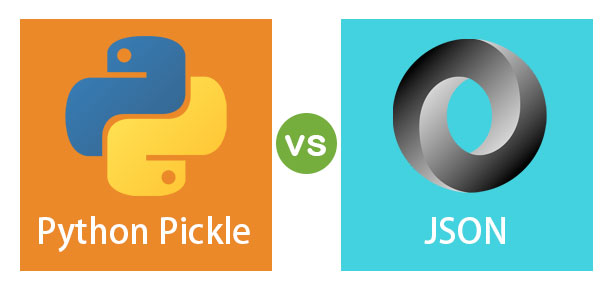Updated March 24, 2023

Difference Between Python Pickle and JSON
Pickling or Serialization is the process of converting a Python object (lists, dict, tuples, etc.) into byte streams that can be saved to disks or can be transferred over the network. The byte streams saved on the file contains the necessary information to reconstruct the original python object. The process of converting byte streams back to python objects is called de-serialization.
JSON stands for JavaScript Object Notation. It was derived from JavaScript but is not specific to one language. JSON is standardized and is supported by almost all languages. This is similar to Pickling, but instead of storing data in binary format, JSON stores data in human-readable text format.
Head to Head Comparison between Python Pickle and JSON (Infographics)
Below are the top 7 differences between Python Pickle vs JSON:
Key Differences Between Python Pickle and JSON
The key differences between a Python Pickle vs JSON are provided and discussed as follows-
- Most of the Pickle module is written in C language and is specific to python only. JSON is derived from JavaScript, but it is not limited to JavaScript only, as the name suggests. It was designed in such a way that it can be used in multiple languages.
- Pickle supports binary serialization format, whereas JSON is for simple text serialization format.
- JSON is useful for common tasks and is limited to certain types of data. It means JSON cannot serialize and de-serialize every python object. Whereas pickle can serialize any arbitrary Python object like lists, tuples, and dictionaries. Even classes and methods can be serialized with Pickle.
- JSON is a lightweight format for data- interchange therefore much faster than Pickle
- JSON supports language interoperability which means it is language independent and can be used in many languages, whereas pickling is specific to python only and is not supported by other languages
- JSON stores data in text format, whereas pickle store data in binary format
- JSON is secure, whereas Pickling is insecure and vulnerable to security threats. Therefore it advised not to unpickle data from unknown sources as it may contain malicious and erroneous data.
Python Pickle vs JSON Comparison Table
Let’s discuss the top comparison between Python Pickle vs JSON:
| Python Pickle | JSON |
| Python Pickle is the process of converting python objects (list, dict, tuples, etc.) into byte streams which can be saved to disks or can be transferred over the network. The byte streams saved on the file contains the necessary information to reconstruct the original python object. The process of converting byte streams back to python objects is called de-serialization. |
JSON stands for JavaScript Object Notation. Although derived from JavaScript, JSON is language interoperable. JSON is another way of storing python objects into a disk so that later on, they can be loaded without having the need to recreate the data again. |
| Pickle lets the user to store data in binary format. | JSON lets the user store data in a human-readable text format. |
| Not only the data fields but with the pickle module, even classes and methods can be serialized and de-serialized. | JSON is limited to certain python objects, and it cannot serialize every python object. |
|
Pickle supports almost all the data types supported by python:
Following data types can be pickled :
|
JSON supports only a subset of python data types.
Following data types are supported by JSON:
Below data types are not supported by JSON:
|
| Pickling is specific to python only, and it does not guarantee cross-language compatibility. Even different python versions are not compatible with each other. It means pickling done in python version 2.x may not work in python version 3.x | JSON is supported by almost all programming languages. JSON is language independent. So even a non Python programmer can use this for data interchange. |
| Serialization and de-serialization with Pickle is a slower process when compared to other available alternatives. | JSON is a lightweight format and is much faster than Pickling. |
| There is always a security risk with Pickle. Unpickling data from unknown sources should be avoided as it may contain malicious or erroneous data. | There are no loopholes in security using JSON, and it is free from security threats. |
Conclusion
Here, we have seen the two most common and easy techniques to serialize data. Both have their own advantages and disadvantages. If the user has no interoperability requirements and is comfortable with the binary format, he can go with Python Pickle, but if interoperability is the constraint for the user and wants a text format, then he can use the JSON module. It’s up to the programmer or the user to choose among them as per their need. However, it is advised not to unpickle data from unknown sources as it may contain malicious and erroneous data.
Recommended Articles
This is a guide to the top difference between Python Pickle vs JSON. Here we also discuss key differences with infographics and comparison table. You may also have a look at the following articles to learn more –


